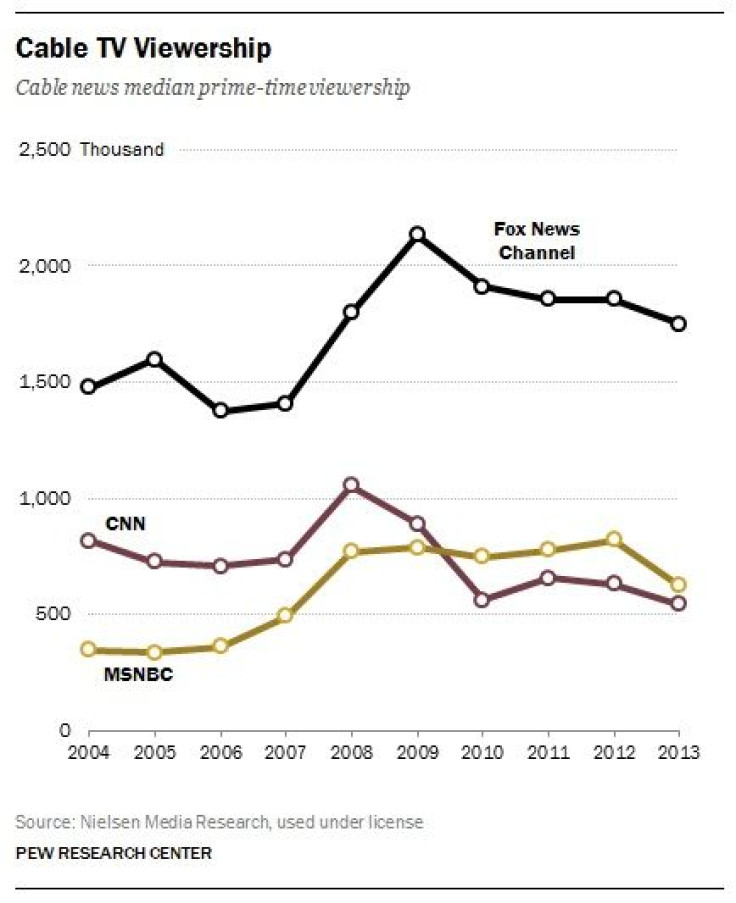Cable News Ratings: CNN, MSNBC Sink Despite July 2014 Plane Crashes, Israel-Gaza Conflict

With three commercial airline crashes, a migrant crisis at the U.S. border, civil war in Ukraine and an escalating conflict in the Middle East, July was a busy month for cable-news networks. But viewers apparently had other plans besides staying glued to their televisions for updates.
All three major U.S. cable-news networks -- Fox News, CNN and MSNBC -- saw a dip in total viewers for the month of July compared to the same period last year, according to Nielsen Media Research. For Fox News, a subsidiary of 21st Century Fox (NASDAQ:FOXA) and the most-watched cable news network for more than a decade, the dip was negligible: Viewership was down 3 percent to just over 1 million total viewers for July.
But for CNN and MSNBC, the falloff was particularly steep. CNN, a division of the Turner Broadcasting part of Time Warner Inc. (NYSE:TWX), saw its audience plunge 23 percent to 402,000 average daily viewers, while MSNBC, a unit of Comcast (NASDAQ:CMCSA), was down 16 percent to 318,000 average daily viewers. In the key 25-54 demographic, the declines are even more striking, with both CNN and MSNBC seeing their audiences drop by more than a third.
Given the prevalence of big news events this month, the numbers are counterintuitive to say the least. What’s going on? Although it’s tempting to look at the decline as a sign of failed strategies -- or even another death knell for the cable-news model as a whole -- media researchers caution not to read too much into unexpected ratings changes taken from short snapshots.
“It’s really hard to wring insight out of a week or a month,” said Jesse Holcomb, lead author of the Pew Research Center’s annual “State of the Media” report, which has tracked cable viewership habits since 2004.
In fact, news ratings are always erratic, and direct year-over-year comparisons are often not very helpful. This July may have been busy, but it lacked one crucial element: the Zimmerman effect. Last year, cable-news viewership was boosted significantly from the George Zimmerman trial verdict on July 14 for Trayvon Martin's killing, as well as the aftermath of racial tension that followed. All three networks scored big during that event, with a combined viewership of more than 10 million viewers, as the Hollywood Reporter noted. Earlier that month, the captured-on-video crash of Asiana Airlines Flight 214 in San Francisco also boosted viewership.
This is not to say cable-news executives have no reason to worry. For MSNBC, this month’s decline is part of a larger trend that began after the re-election of Barack Obama in November 2012. Since that time, the left-leaning network has taken a steady ratings hit, as have the president’s poll numbers. “You definitely see MSNBC struggling ratings-wise over the past year,” Holcomb said. “They’ve been trying to fill that niche that Fox had carved out among the right, and they’ve had some hits and misses.”
CNN, too, has struggled to gain much ground against the dominant Fox, but it has something MSNBC lacks -- namely, its reputation as the place to turn during serious breaking news. In the days that followed the shooting down of Malaysia Airlines Flight MH17 over Ukraine, CNN’s audience jumped by a whopping 87 percent, while Fox saw only a 16 percent increase. MSNBC’s audience grew by a mere 3 percent, and in fact its primetime numbers declined by 4 percent in the 25 -54 demo.

The unbeatable Fox News had the top 14 highest-rated shows on cable news, with Bill O’Reilly’s “The O’Reilly Factor” at No. 1 with 2.8 million average nightly viewers, followed by Megyn Kelly’s “The Kelly File” with 2.3 million. But Holcomb pointed out that not even Fox is safe from the myriad market changes slowly disrupting the cable-news industry as a whole, including the growing trend of cord cutters and inexorable shifts in the way young people consume news. Research from Pew shows total viewership for Fox, CNN and MSNBC peaked around the 2008 presidential election, and has been on slow a steady decline since, leaving all three networks struggling to attract fresh eyeballs and fighting over a larger piece of a shrinking pie. “It’s an aging audience for cable news,” Holcomb said. “These networks, as much as they may try, are not necessarily able to build up a younger audience in the way they want to.”
Got a news tip? Email me. Follow me on Twitter @christopherzara.
© Copyright IBTimes 2024. All rights reserved.












